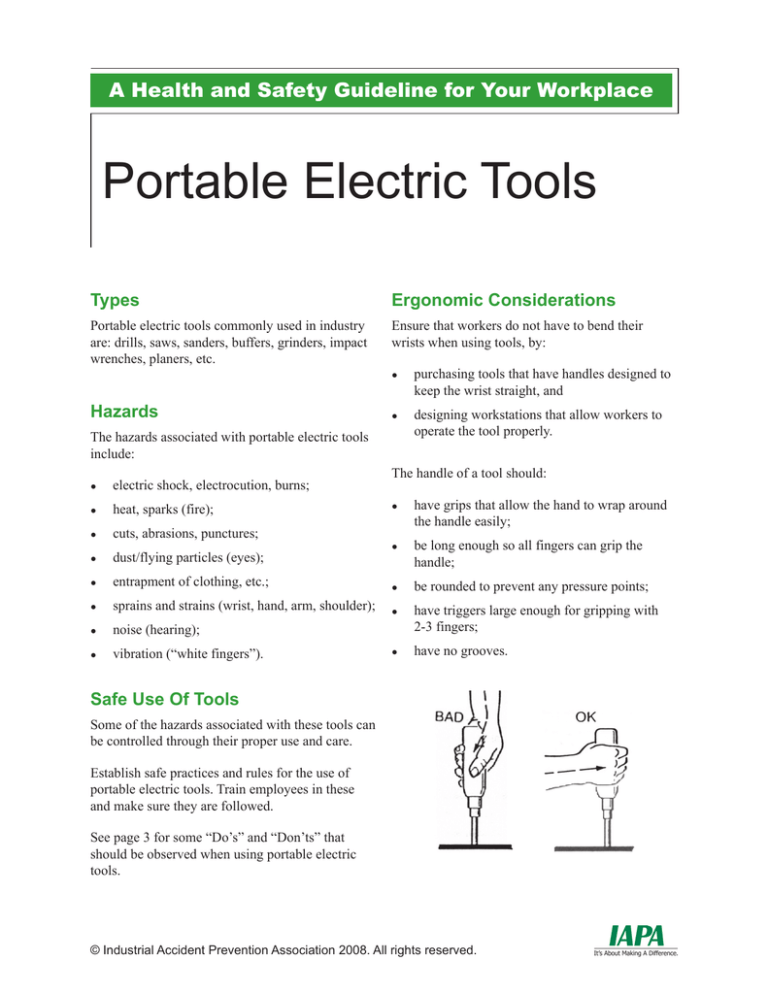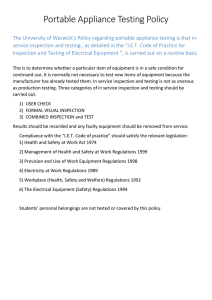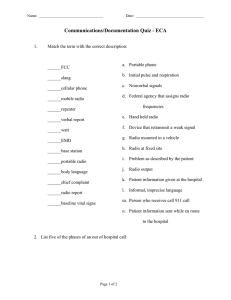
A Health and Safety Guideline for Your Workplace
Portable Electric Tools
Types
Ergonomic Considerations
Portable electric tools commonly used in industry
are: drills, saws, sanders, buffers, grinders, impact
wrenches, planers, etc.
Ensure that workers do not have to bend their
wrists when using tools, by:
Hazards
●●
purchasing tools that have handles designed to
keep the wrist straight, and
●●
designing workstations that allow workers to
operate the tool properly.
The hazards associated with portable electric tools
include:
●●
electric shock, electrocution, burns;
●●
heat, sparks (fire);
●●
cuts, abrasions, punctures;
●●
dust/flying particles (eyes);
●●
The handle of a tool should:
●●
have grips that allow the hand to wrap around
the handle easily;
●●
be long enough so all fingers can grip the
handle;
entrapment of clothing, etc.;
●●
be rounded to prevent any pressure points;
●●
sprains and strains (wrist, hand, arm, shoulder);
●●
●●
noise (hearing);
have triggers large enough for gripping with
2-3 fingers;
●●
vibration (“white fingers”).
●●
have no grooves.
Safe Use Of Tools
Some of the hazards associated with these tools can
be controlled through their proper use and care.
Establish safe practices and rules for the use of
portable electric tools. Train employees in these
and make sure they are followed.
See page 3 for some “Do’s” and “Don’ts” that
should be observed when using portable electric
tools.
© Industrial Accident Prevention Association 2008. All rights reserved.
Training
Ontario’s Occupational Health and Safety Act
requires that every precaution be taken to ensure
the safety of workers (s.25). Where portable
electric tools are concerned, there are pitfalls for
the inexperienced and the uninformed. Because
accidents involving electrical tools can result in
fatalities, electrical hazards should be emphasized
during training.
Provide lightweight tools that can be easily
supported by one hand, or provide tools with two
handles to permit better handling.
If the tool weighs more than 0.5 kg (1 lb), support
it with a counter balanced harness.
Provide tools with handles covered with cork,
rubber or plastic to reduce vibration transmitted to
the hand.
Instruct workers to:
●●
hold the tool so that its centre of gravity is
located close to the body;
●●
minimize kickback from the tool;
●●
rest their hands by laying the tool down or
inserting it in a holster when it is not being
used.
Using a tool in a flammable atmosphere can cause
an explosion and is perhaps the second most
dangerous hazard.
To help avoid serious injury, include the following
in any training program.
●●
What to use the tool for and how to hold and
operate it
●●
Hazards of improper use
●●
Manufacturer’s directions
●●
Protective equipment to be used
●●
Operating problems that could happen (i.e.,
binding, seizing, breakage)
●●
Pre-use checks to be carried out
●●
How to evaluate possible environmental
hazards (i.e., flammability of substances,
lighting, water)
●●
Use of attachments – proper selection (size,
speed) and installation
●●
Inspection procedures
●●
Health effects of noise and vibration and what
is being done to control the noise and vibration
produced by tools used in the workplace
●●
How to transport and store the tools
Portable Electric Tools
© Industrial Accident Prevention Association 2008. All rights reserved.
2
Use Tools Safely
Follow These Rules
●●
Always review the manufacturer’s
instructions before use.
●●
Know the hazards.
●●
Know the personal protective equipment needs.
●●
Inspect the tool before use.
DO
DON’T
55
Check the nameplate to ensure that the power
source is correct for the tool.
44
Work where floor is wet or damp without
extreme precautions.
55
Test tools before starting work.
44
Carry tools up a ladder.
55
Make sure the tool is in safe condition –
cleaned, repaired, oiled.
44
Operate grinding wheels at speeds beyond
their rating.
55
Make sure the ground pin is in place and that
there are no cuts in the cord.
44
Use the cord to pull out plugs or lift tools.
44
Use tools where flammable gases or vapours
may be present.
44
Make improvised repairs.
44
Work on makeshift platforms.
44
Use tools with defective guards.
44
Hang cord over sharp edges, through water,
where they can be run over by vehicles or
tripped over.
44
Tape cords to repair them.
44
Wear loose clothing or gloves.
55
Test the ground connection on 3 wire system
or check that tool is double insulated.
55
Make sure switch is operating freely. Keep
finger off switch when carrying a tool.
55
Ensure that guards (e.g., on saws, etc.) are in
place and that they are functioning properly.
55
If brushes are sparking excessively, obtain a
replacement tool.
55
Wear suitable eye and foot protection.
55
Avoid accidental starting.
55
Remove adjusting keys/wrenches before
turning tool on or plugging it in.
55
Pull out power plug before adjusting or
making changes, or when the tool is not in use.
55
Always hold the tool firmly.
55
Hoist tools up a ladder instead of carrying
them.
55
Store tool where it won’t be damaged.
Portable Electric Tools
© Industrial Accident Prevention Association 2008. All rights reserved.
3
Maintenance
Applicable Legislation
Review manufacturer’s instructions before
establishing maintenance procedures. A planned
program of maintenance will include the following:
Regulation for Industrial Establishments made
under the Occupational Health and Safety Act:
s.40
Electrical Equipment Certification
s.43
Tools type, near live conductors
s.44
Grounding connection for electric tools
●●
Regular inspection, cleaning and oiling of tools
●●
Check of grounding protection or double
installation
●●
Inspection of extension cords and plugs
●●
Check for damage to frame, motor or parts
●●
Motor inspection and parts replacement
●●
Verification of guards. Movable guards that
operate freely (e.g., on saws, etc.) will be part
of the check
●●
Checking with operators if any unusual
situation is suspected
●●
Inspection of switches
●●
Test for short circuits
●●
●●
After inspecting and reassembling the tool, test
it for “ground” before releasing it
C22.2 No. 71.1-M89 (R 2004): Portable
Electric Tools
●●
CAN/CSA-Z94.3-07: Eye and Face Protection
●●
CAN/CSA-Z195-02: Protective Footwear
●●
Adjustments as recommended by
manufacturers
●●
Re-sharpen blades, bits, etc., in accordance
with manufacturer’s instructions
●●
Check chucks, collets, etc.
●●
A final visual check
●●
Tag and record
s.44.1 For tools used outdoors or in wet locations
– Requirement for ground fault circuit
interrupters
s.44.2 Investigation and removal of ground faults
that pose a hazard
s.139 Noise
References
Canadian Standards Association (CSA) Standards:
THE INSPECTION REPORT ON THE NEXT
PAGE MAY BE USED AS A BULLETIN ITEM
Portable Electric Tools
© Industrial Accident Prevention Association 2008. All rights reserved.
4
Inspection Report
The checklist below is a sample which you may modify in keeping with your own needs. Although primarily for a
maintenance or department check, it may be useful for a pre-shift check as well.
Tool No:
Type:
Location:
Material:
Date Purchased:
Length:
þ Acceptable
ý Unacceptable
Dates of Inspection
Grounding/double insulation OK
Plug and cord free from defects
Switch operates freely
Guard in good repair and operates correctly
No wobble in shaft
Adjusting key available
Brushes not sparking excessively
No burrs on casing
Attachments suitable (re speed, size)
Flexible shaft in good condition
Proper storage available
Tool shaft turns freely
No grease, metallic dust on tool
Ventilating slots are clean
Certification:
INITIALS OF PERSON MAKING INSPECTION
Notes:
Portable Electric Tools
© Industrial Accident Prevention Association 2008. All rights reserved.
5
© INDUSTRIAL ACCIDENT PREVENTION
ASSOCIATION, 2002, 2005, 2006, 2008.
All rights reserved. As part of IAPA’s mission to inform and
educate, IAPA permits users to reproduce this material for their
own internal training and educational purposes only. For any
other purpose, including use in conjunction with fee for service
or other commercial activities, no part of this material may be
used, reproduced, stored in a retrieval system, or transmitted in
any form or by any means, electronic, mechanical, photocopy,
recorded, or otherwise, without the express prior written
permission of the Industrial Accident Prevention Association.
The information contained in this material is provided
voluntarily as a public service. No warranty, guarantee
or representation is made by IAPA as to the correctness,
suitability, fitness, or sufficiency of any information contained
in this material. Use of this material means that the user agrees
that IAPA and its employees will not have and are released
from any liability whatsoever, however caused or arising, in
connection therewith. Users also acknowledge that it cannot
be assumed that all acceptable safety measures are contained
in this material or that additional measures may not be required
in the conditions or circumstances that are applicable to the
user or his/her organization, and that the user will personally
make his/her own assessment of the information contained in
this material.
While IAPA does not undertake to provide a revision service
or guarantee accuracy, we shall be pleased to respond to your
individual requests for information.
Revised: May 2008
Industrial Accident Prevention Association
Toll-free: 1-800-406-IAPA (4272)
Website: www.iapa.ca
Portable Electric Tools



